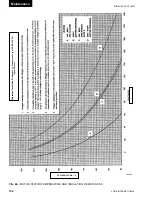
FORM 160.55-O1 (920)
147
YORK INTERNATIONAL
FIG. 64 –
SATURATION CURVE
LD00474
SHELL CODES
COOLER
COMPRESSOR
G0, G1, G3
B
890
900
G0, G1, G3
C
890
900
H1, H3
−
970
975
J1, J3
−
1130 1125
K1, K3
−
1270 1275
G0, G1, G3
E
890
900
H1, H3
−
970 975
J1, J3
−
1130 1125
K1, K3
−
1270 1275
L1, L3
−
1390 1400
K4, K6
F
1390
1400
K7, K9
−
1530 1550
L4, L6
−
1590
1600
FACTORY
CHARGE SHIPPED
LBS.
When this point is reached, practically all of the air has
been evacuated from the system, but there is still a small
amount of moisture left. In order to provide a medium
for carrying this residual moisture to theVacuum pump,
nitrogen should be introduced into the system to bring
REFRIGERANT CHARGING
it to atmospheric pressure and the indicator temperature
will return to approximately ambient temperature. Close
off the system again, and start the second evacuation.
The relatively small amount of moisture left will be car-
ried out through theVacuum pump and the temperature or
pressure shown by the indicator should drop uniformly
until it reaches a temperature of 35°F or a pressure of
5mm Hg.
When theVacuum indicator registers this tempera-
ture or pressure it is a positive sign that the system is
evacuated and dehydrated to the recommended limit.
If this level can not be reached, it is evident that there
is a leak somewhere in the system. Any leaks must be
corrected before the indicator can be pulled down to
35°F or 5mm Hg. in the primary evacuation. During
the primary pull down keep a careful watch on the wet
bulb indicator temperature, and do not let it fall below
35°F. If the temperature is allowed to fall to 32°F the
water in the test tube will freeze, and the result will be
a faulty temperature reading.
To avoid the possibility of freezing the liquid within the
cooler tubes when charging an evacuated system, only
refrigerant vapor from the top of the drum or cylinder
must be admitted to the system until the system pressure
is raised above the point corresponding to the freezing
point of the cooler liquid. For water, the pressure cor-
responding to the freezing point is 20.4 in Hg.Vacuum
for R-123 (at sea level).
While charging, every precaution must be taken to
prevent moisture laden air from entering the system.
Make up a suitable charging connection from new cop-
per tubing to fit between the system charging valve
and the fitting on the charging drum. This connection
should be as short as possible but long enough to permit
sufficient flexibility for changing drums. The charging
connection should be purged each time a full container
of refrigerant is connected and changing containers
should be done as quickly as possible to minimize the
loss of refrigerant.
Refrigerant may be furnished in drums containing either
100, 200 or 650 lbs. of refrigerant. These drums are not
returnable and they should be stored for future use if
it should ever become necessary to remove refrigerant
from the system.
TABLE 4 –
REFRIGERANT CHARGE
8










































